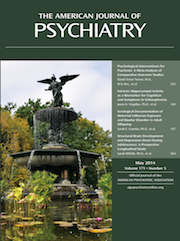Altered Brain Activation During Action Imitation and Observation in Schizophrenia: A Translational Approach to Investigating Social Dysfunction in Schizophrenia
Abstract
Objective
Social impairments are a key feature of schizophrenia, but their underlying mechanisms are poorly understood. Imitation, a process through which we understand the minds of others, involves the so-called mirror neuron system, a network comprising the inferior parietal lobe, inferior frontal gyrus, and posterior superior temporal sulcus. The authors examined mirror neuron system function in schizophrenia.
Method
Sixteen medicated schizophrenia patients and 16 healthy comparison subjects performed an action imitation/observation task during functional MRI. Participants saw a video of a moving hand or spatial cue and were instructed to either execute finger movements associated with the stimulus or simply observe. Activation in the mirror neuron system was measured during imitative versus nonimitative actions and observation of a moving hand versus a moving spatial cue. These contrasts were compared across groups.
Results
Activation in the mirror neuron system was less specific for imitation in schizophrenia. Relative to healthy subjects, patients had reduced activity in the posterior superior temporal sulcus during imitation and greater activity in the posterior superior temporal sulcus and inferior parietal lobe during nonimitative action. Patients also showed reduced activity in these regions during action observation. Mirror neuron system activation was related to symptom severity and social functioning in patients and to schizotypal syndrome in comparison subjects.
Conclusions
Given the role of the inferior parietal lobe and posterior superior temporal sulcus in imitation and social cognition, impaired imitative ability in schizophrenia may stem from faulty perception of biological motion and transformations from perception to action. These findings extend our understanding of social dysfunction in schizophrenia.



